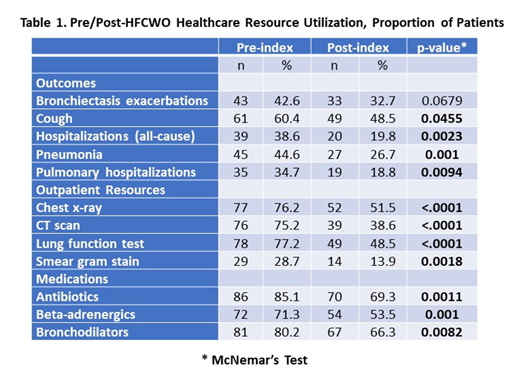Abstract
Rationale: High Frequency Chest Wall Oscillation (HFCWO) is a key airway clearance technique to prevent deterioration due to inflammation and infection in patients with non-cystic fibrosis bronchiectasis (NCFBE). Previous studies have shown improvement in lung function and clinical outcomes following receipt of HFCWO. This study aimed to understand patient characteristics and compare healthcare resource utilization (HCRU) and outcomes both before and after HFCWO among patients with NCFBE, in a large database representative of the US commercially-insured population.
Methods: Retrospective cohort analysis of patients with NCFBE having received HFWCO was conducted using IQVIA’s Pharmetrics Plus® for MedTech, one of the largest US health plan databases of adjudicated integrated medical and pharmacy claims. Patients were required to have evidence of HFCWO during the selection window (7/1/2018 – 6/30/2019); first claim with HFCWO was termed ‘index date’. Continuous enrollment of each patient ≥24 months prior to (pre-index) and ≥12 months including and following the index date (post-index) was required (study period). Patients with evidence of NCFBE over the study period were included. Only patients incident to HFCWO (no evidence of HFCWO during the 12 month pre-index period) remained in the study sample. Baseline demographic and clinical characteristics were reported (over the 12 month pre-index period) while HCRU and outcomes were compared 12 months pre- and post-HFCWO (index date) using McNemar’s test.
Results: 1,095 HFCWO patients were identified during the selection window; 101 of those patients were included in the study following application of the inclusion/exclusion criteria. The mean (SD) age of the sample was 71.6 (76.0) (those aged ≥85 were capped at 85), with 55.4% ≥75 years of age. 69.3% of the patients were female with the majority of patients (38.6%) located in the Midwest. The most common payer type was Medicare Advantage (67.3%). Common comorbidities included essential primary hypertension (65.3%), COPD (65.3%), hyperlipidemia (62.4%) and shortness of breath (54.5%). Over the pre-index period, evidence of a complete blood count, ER visit or lipid panel were reported by 68.3%, 58.4%, and 43.6% of patients, respectively. When compared to the 12 month pre-index period, the proportion of patients experiencing key HCRU metrics significantly decreased in the 12 month post-index period following HFCWO use, particularly hospitalizations (p=0.0023), antibiotic use (p=0.0011) and pneumonia (p=0.001) (see Table 1).
Conclusion: Patients with NCFBE that utilized HFCWO had improved health outcomes and less HCRU following the treatment as compared to before.

1 IQVIA, Falls Church, VA, USA; IQVIA, Plymouth Meeting, PA, USA
MD, KM, ND, JC and AR are all employees of IQVIA, which received funding for this study from Electromed, Inc.
